
by Gary Mintchell | Aug 30, 2018 | Technology
Peter Diamandis, entrepreneur and founder of Singularity University and XPRIZE among many other things, interviewed his friend Ray Kurzweil at the Googleplex for a 90-minute (live) webinar on disruptive and dangerous ideas.

Diamandis promotes what he calls Abundance Thinking. He says, “By consuming and considering a steady diet of ‘crazy ideas,’ you train yourself to think bigger and bolder… a critical requirement for making impact. As humans, we are linear and scarcity-minded. As entrepreneurs, we must think exponentially and abundantly. At the end of the day, the formula for a true breakthrough is equal to ‘having a crazy idea’ you believe in, plus the passion to pursue that idea against all naysayers and obstacles.”
Kurzweil is Co-founder and Chancellor of Singularity University. He is also an XPRIZE Trustee, the Director of Engineering at Google, and “one of the best predictors of our exponential future.”
Diamandis and Kurzweil recorded a 90-minute conversation recorded on the YouTube video linked above. Here are 3 compelling ideas that came from the conversation as reported by Diamandis and sent in his newsletter. If you haven’t run across him, I recommend subscribing and having your mind blown.
The Nation-State Will Soon Be Irrelevant
Historically, we humans don’t like change. We like waking up in the morning and knowing that that the world is the same as the night before.
That’s one reason why government institutions exist: to stabilize society.
But how will this change in 20 or 30 years? What role will stabilizing institutions play in a world of continuous, accelerating change?
“Institutions stick around, but they change their role in our lives,” Ray explained. “They already have. The nation-state is not as profound as it was. Religion used to direct every aspect of your life, minute to minute. It’s still important in some ways, but it’s much less important, much less pervasive. [It] plays a much smaller role in most people’s lives than it did, and the same is true for governments.”
Ray continues: “We are fantastically interconnected already. Nation-states are not islands anymore. So we’re already much more of a global community. The generation growing up today really feels like world citizens much more than ever before, because they’re talking to people all over the world and it’s not a novelty.”
(Diamandis) previously shared (his) belief that national borders have become extremely porous, with ideas, people, capital and technology rapidly flowing between nations. In decades past, your cultural identity was tied to your birthplace. In the decades ahead, your identify is more a function of many other external factors. If you love space, you’ll be connected with fellow space-cadets around the globe more than you’ll be tied to someone born next door.
We’ll hit longevity escape velocity before we realize we’ve hit it
Ray and I share a passion for extending the healthy human lifespan.
I frequently discuss Ray’s concept of “longevity escape velocity” — the point at which, for every year that you’re alive, science is able to extend your life for more than a year.
Scientists are continually extending the human lifespan, helping us cure heart disease, cancer, and eventually neurodegenerative disease. This will keep accelerating as technology improves.
During my discussion with Ray, I asked him when he expects we’ll reach “escape velocity…”
His answer? “I predict it’s likely just another 10 to 12 years before the general public will hit longevity escape velocity.”
“At that point, biotechnology is going to have taken over medicine,” Ray added. “The next decade is going to be a profound revolution.”
From there, Ray predicts that nanorobots will “basically finish the job of the immune system,” with the ability to seek and destroy cancerous cells and repair damaged organs.
As we head into this sci-fi-like future, your most important job for the next 15 years is to stay alive. “Wear your seatbelt until we get the self-driving cars going,” Ray jokes.
The implications to society will be profound. While the scarcity-minded in government will react saying, “Social Security will be destroyed,” the more abundance-minded will realize that extending a person’s productive earning lifespace from 65 to 75 or 85 years old would be a massive boom to the GDP.
Technology will help us define and actualize human freedoms
The third dangerous idea from my conversation with Ray is about how technology will enhance our humanity, not detract from it.
You may have heard critics complain that technology is making us less human, and increasingly disconnected.
Ray and I share a slightly different viewpoint: that technology enables us to tap into the very essence of what it means to be human.
“I don’t think humans even have to be biological,” explained Ray. “I think humans are the species that changes who we are.”
Ray argues that this began when humans developed the earliest technologies — fire and stone tools. These tools gave people new capabilities, and became extensions of our physical bodies.
At its base level, technology is the means by which we change our environment, and change ourselves. This will continue, even as the technologies themselves evolve.
“People say, ‘Well, do I really want to become part machine?’ You’re not even going to notice it,” says Ray, “because it’s going to be a sensible thing to do at each point.”
Today, we take medicine to fight disease and maintain good health, and would likely consider it irresponsible if someone refused to take a proven, life-saving medicine.
In the future, this will still happen — except the medicine might have nanobots that can target disease, or will also improve your memory so you can recall things more easily.
And because this new medicine works so well for so many, public perception will change. Eventually, it will become the norm… as ubiquitous as penicillin and ibuprofen are today.
In this way, ingesting nanorobots, uploading your brain to the cloud, and using devices like smart contact lenses can help humans become, well, better at being human.
Ray sums it up: “We are the species that changes who we are to become smarter and more profound, more beautiful, more creative, more musical, funnier, sexier.”
My Take
I began studying international relations 50 years ago under an interesting professor. He was well up the chain at the CIA, Colonel in US Army Intelligence, PhD from Georgetown. Also, he was sort of a rebel. He took a liking to a somewhat rebellious kid from the farmlands.
It’s evident that the nation-state is in its death-throes. Trump and Xi and Putin are all trying to find ways to reassert power over a society and businesses that are increasingly global. Yes, there are emotional loyalties. But take a big step back and look at the sweep of history of the past 150 years. Think about what you see.
Technology throughout the entire history of humans has been both good and bad. But overall, it has benefitted humans. We eat better (well within our power of choice—don’t choose Doritos), live longer, have better housing and clothing, travel faster. We also have machines to help with backbreaking and dangerous labor.
As Diamandis says, think abundance rather than scarcity.

by Gary Mintchell | Aug 24, 2018 | Automation, Operator Interface, Technology, Workforce
Simulators are great training tools. It sure beats flying 777s around for your annual pilot recert. Gaming technology has become so good along with many other technologies, that operators of process plants and machinery should be well trained to respond appropriately to any emergency.
Georgia Institute of Technology sent this information about an advancement in simulation for operator training. Good stuff.
A simulator that comes complete with a virtual explosion could help the operators of chemical processing plants – and other industrial facilities – learn to detect attacks by hackers bent on causing mayhem. The simulator will also help students and researchers understand better the security issues of industrial control systems.
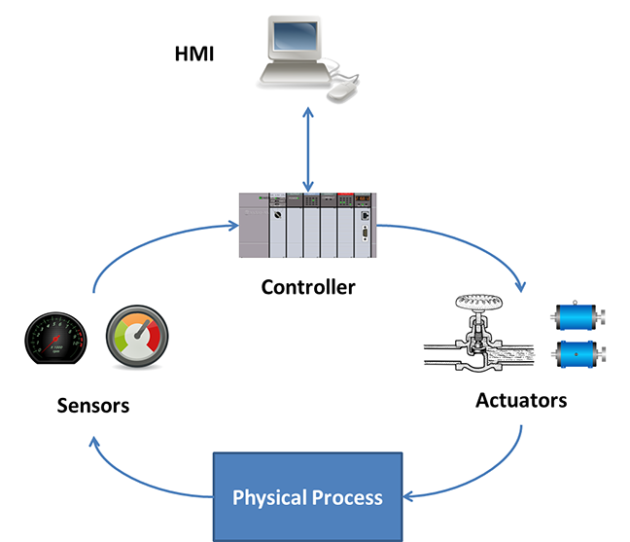
This flow chart shows data flows within a simulated chemical processing facility.
Facilities such as electric power networks, manufacturing operations and water purification plants are among the potential targets for malicious actors because they use programmable logic controllers (PLCs) to open and close valves, redirect electricity flows and manage large pieces of machinery. Efforts are underway to secure these facilities, and helping operators become more skilled at detecting potential attacks is a key part of improving security.
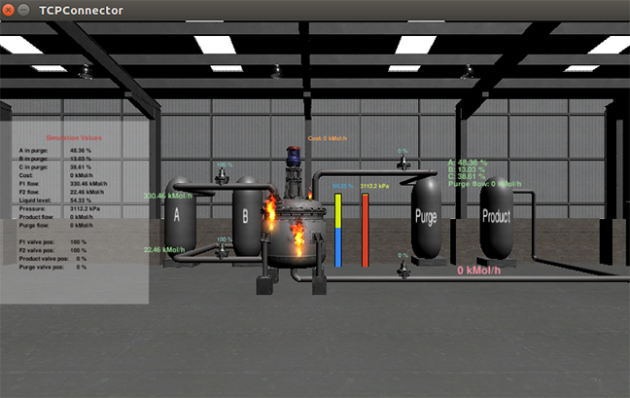
Screen captures show a simulated explosion in a chemical processing plant precipitated by a cyberattack on the system.
“The goal is to give operators, researchers and students experience with attacking systems, detecting attacks and also seeing the consequences of manipulating the physical processes in these systems,” said Raheem Beyah, the Motorola Foundation Professor in the School of Electrical and Computer Engineering at the Georgia Institute of Technology. “This system allows operators to learn what kinds of things will happen. Our goal is to make sure the good guys get this experience so they can respond appropriately.”
Details of the simulator were presented August 8 at Black Hat USA 2018, and August 13 at the 2018 USENIX Workshop on Advances in Security Education. The simulator was developed in part by Atlanta security startup company Fortiphyd Logic, and supported by the Georgia Research Alliance.
The simulated chemical processing plant, known as the Graphical Realism Framework for Industrial Control Simulations (GRFICS), allows users to play the roles of both attackers and defenders – with separate views provided. The attackers might take control of valves in the plant to build up pressure in a reaction vessel to cause an explosion. The defenders have to watch for signs of attack and make sure security systems remain operational.
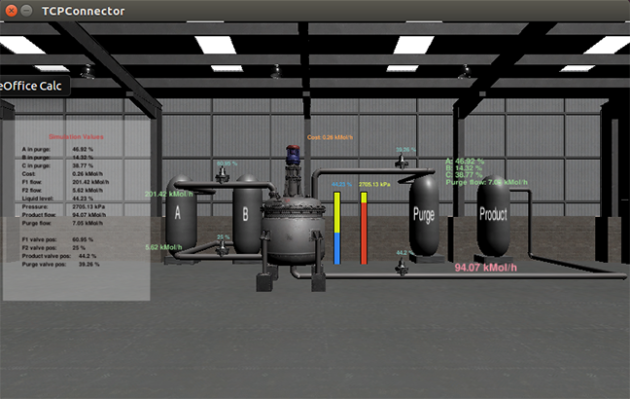
Screen capture shows a chemical processing plant in which critical parameters are rising due to false process data and control commands injected by an attacker.
Of great concern is the “man-in-the-middle” attack in which a bad actor breaks into the facility’s control system – and also takes control of the sensors and instruments that provide feedback to the operators. By gaining control of sensors and valve position indicators, the attacker could send false readings that would reassure the operators – while the damage proceeded.
“The pressure and reactant levels could be made to seem normal to the operators, while the pressure is building toward a dangerous point,” Beyah said. Though the readings may appear normal, however, a knowledgeable operator might still detect clues that the system has been attacked. “The more the operators know the process, the harder it will be to fool them,” he said.
The GRFICS system was built using an existing chemical processing plant simulator, as well as a 3D video gaming engine running on Linux virtual machines. At its heart is the software that runs PLCs, which can be changed out to represent different types of controllers appropriate to a range of facilities. The human-machine interface can also be altered as needed to show a realistic operator control panel monitoring reaction parameters and valve controller positions.
“This is a complete virtual network, so you can set up your own entry detection rules and play on the defensive side to see whether or not your defenses are detecting the attacks,” said David Formby, a Georgia Tech postdoctoral researcher who has launched Fortiphyd Logic with Beyah to develop industrial control security products. “We provide access to simulated physical systems that allow students and operators to repeatedly study different parameters and scenarios.”
GRFICS is currently available as an open source, free download for use by classes or individuals. It runs on a laptop, but because of heavy use of graphics, requires considerable processing power and memory. An online version is planned, and future versions will simulate the electric power grid, water and wastewater treatment facilities, manufacturing facilities and other users of PLCs.
Formby hopes GRFICS will expand the number of people who have experience with the security of industrial control systems.
“We want to open this space up to more people,” he said. “It’s very difficult now to find people who have the right experience. We haven’t seen many attacks on these systems yet, but that’s not because they are secure. The barrier for people who want to work in the cyber-physical security space is high right now, and we want to lower that.”
Beyah and Formby have been working for several years to increase awareness of the vulnerabilities inherent in industrial control systems. While the community still has more to do, Beyah is encouraged.
“Several years ago, we talked to a lot of process control engineers as part of the NSF’s I-Corps program,” he said. “It was clear that for many of these folks then, security was not a major concern. But we’ve seen changes, and lots of people are now taking system security seriously.”
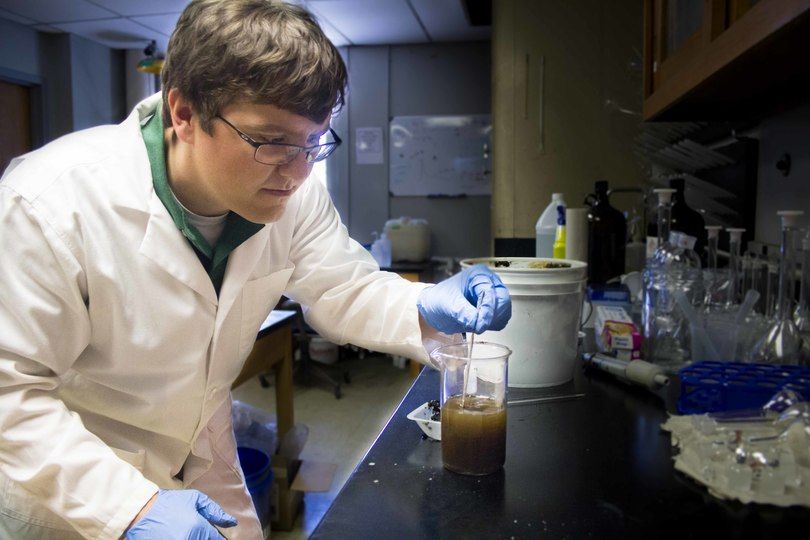
by Gary Mintchell | Aug 2, 2018 | News, Organizations
Something good can come from the wastes of dirty coal mining in West Virginia. West Virginia University researchers are opening a new facility to capture valuable materials from acid mine drainage from coal mining – turning the unwanted waste into critical components used in today’s technology-driven society.
Through a collaborative research and development program with the National Energy Technology Laboratory, part of the U.S. Department of Energy, WVU is opening the Rare Earth Extraction Facility to bolster domestic supplies of rare earths, reduce the environmental impact of coal-mining operations, reduce production costs and increase efficiency for processing market-ready rare earths.
Additionally, the technology could create jobs, helping to revive economies that have been historically dependent on the coal industry.
“Research on rare-earth extraction is one way that our University is fulfilling its most important mission—which is the land grant mission—to advance the prosperity of the people of this state,” President Gordon Gee said.
Representatives from WVU, NETL, DOE, representatives from West Virginia’s congressional delegation and others gathered July 18 in the High Bay Research Lab at the WVU Energy Institute’s National Research Center for Coal and Energy on campus to tour the new Rare Earth Extraction Facility and mark the start of this exciting new phase of research.
Brian Andson, director of the WVU Energy Institute, hosted the event and conveyed statements of support from the members of the state’s congressional delegation, including Rep. David McKinley and Sens. Joe Manchin and Shelley Moore Capito.
In addition, WVU welcomed keynote speaker Steven Winberg, DOE assistant secretary for fossil energy.
“It’s a pleasure to be in West Virginia, because West Virginians understand what it really means to have an ‘all-of-the-above’ energy strategy,” he said.
WVU is partnering with Rockwell Automation to facilitate market readiness through use of their sensor and control technologies in the new WVU facility.
Paul McRoberts, regional industry mining, metals and cement manager at Rockwell Automation, a 30-year veteran of the industry, said that this is one of the most exciting projects he has been a part of during his career and is excited to see the results of the new facility.
The facility is the researchers’ phase two project, worth $3.38 million, funded by NETL with substantial matching funding from WVU’s private sector partners. It follows on an earlier, phase one project, worth $937,000, to study acid mine drainage as feedstock for rare-earth extraction. The goal of the pilot facility is to test the technical and economic feasibility of scaling-up the technology to commercialize the separation and extraction process.
In addition, the team will be working to define a U.S.-based supply chain including the sludges created during acid mine drainage treatment and upstream to the acid-mine drainage source.
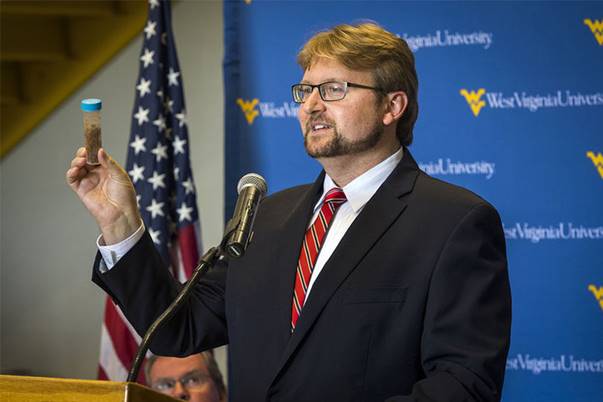
Brian Anderson holding a sample of dried acid mine drainage sludge containing rare earth elements. Photo by: M.G. Ellis
Neither rare nor earth
The name “rare earth elements” is a misnomer for important chemical elements that are actually neither rare nor earths.
A collection of 16 elements that hang off the bottom of the periodic table, they are moderately abundant but well dispersed in the Earth’s crust. They are identified as rare because it is unusual to find them in large concentrations.
The elements are all metals that carry very similar properties. In rare cases they are found in deposits together. Unlike an element such as gold, natural rare earth deposits never occur as pure metals, but are bonded in low-value minerals, making extraction challenging.
Conventional rare-earth recovery methods require an expensive, difficult and messy extraction process that generates large volumes of contaminated waste. China has been able to provide a low-cost supply of rare earths using these methods, and therefore, dominates the global market.
The conventional mining and extraction processes require mining ore from mineral deposits in rock, which is crushed into a powder, dissolved in powerful chemical solutions and filtered. The process is repeated multiple times to retrieve rare earth oxides. Additional processing and refining separates the oxides from their tight bonds and further groups them into light rare earths and heavy rare earths.
In usable form, these elements are necessary components of modern technologies. They are used in cellular phones, computers, televisions, magnets, batteries, catalytic converters, defense applications and many more segments of modern society.
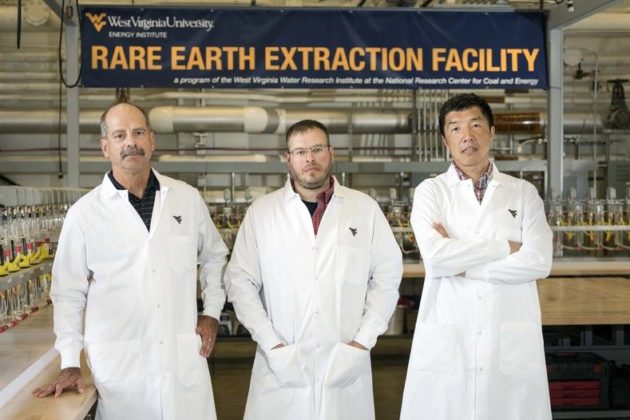
Members of the WVU rare-earth research team from L to R: Paul Ziemkiewicz, director of the West Virginia Water Research Institute; Chris Vass, facility operator; and Xingbo Liu, professor and associate chair of research, Statler College of Engineering and Mineral Resources, in the new Rare Earth Extraction Facility at the WVU Energy Institute/National Research Center for Coal and Energy. Photo by: M.G. Ellis
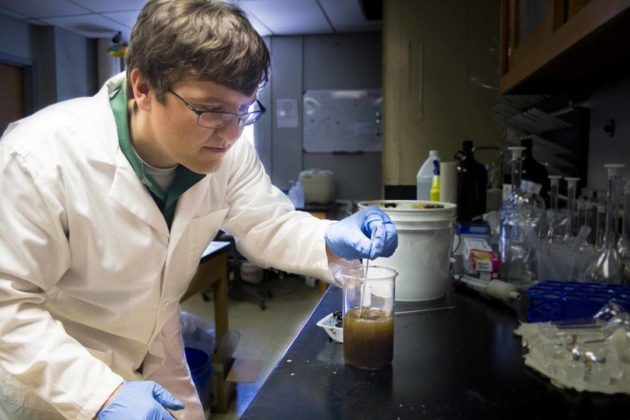
Aaron Noble, associate professor of mining and minerals engineering at Virginia Tech, is a co-investigator on the project working with the WVU team.
Paul Ziemkiewicz, director of the West Virginia Water Research Institute and principal investigator on the project, is an expert in acid mine drainage. He found that acid mine drainage, a byproduct of coal mining, “naturally” concentrates rare earths. Active coal mines, and in many cases state agencies, are required to treat the waste, which in turn, yields solids that are enriched in rare earth elements.
“Acid mine drainage from abandoned mines is the biggest industrial pollution source in Appalachian streams, and it turns out that these huge volumes of waste are essentially pre-processed and serve as good rare earth feedstock,” Ziemkiewicz said. “Coal contains all of the rare earth elements, but it has a substantial amount of the heavy rare earths that are particularly valuable.”
Studies show that the Appalachian basin could produce 800 tons of rare earth elements per year, approximately the amount the defense industry would need.
“Currently, acid-mine-drainage treatment is a liability, an environmental obligation,” Ziemkiewicz said. “But it could turn into a revenue stream, incentivizing treatment and creating economic opportunity for the region.”
Two-step process
Ziemkiewicz, Xingbo Liu, professor of mechanical engineering in the Statler College of Engineering and Mineral Resources, and Aaron Noble, associate professor of mining and minerals engineering at Virginia Tech, have designed the processing facility from the ground up using advanced separation technologies. Chris Vass, PE, is the operator of the new facility and a Summersville, West Virginia, native.
The researchers are using a two-step process to separate the rare earths from acid mine drainage: acid leaching and solvent extraction, which they call ALSX.
Researchers will dissolve the sludge in an acid. That solution will then be transferred to glass mixers and settlers that will make an emulsion that allows the oil phase and its extractant chemical to grab rare earths from the water, leaving the non-rare earth base metals like iron in the water
When that process is completed, the rare-earth-laden organic liquid enters another series of mixers and settlers that will strip the rare earths out as a concentrated solution and precipitate the rare earths as a solid, creating a concentrated rare earth oxide that can then be refined and further concentrated into pure rare earth metals to supply the metal refining industry.
The goal of the project is to produce three grams of rare earth concentrate per hour.
“For example, scandium, one of these rare earths, is worth about $4,500 per kilogram as an oxide, the form that it will leave this facility,” Anderson said. After refining, it would be worth $15,000 per kilogram.”
Unused materials will be returned to the acid mine drainage treatment plant’s disposal system, resulting in a negligible environmental footprint.
“This process uses an existing waste product that is abundant in our region,” Ziemkiewicz said. “It is also much easier to extract and requires much milder acids and has negligible waste materials when compared to conventional rare-earth recovery methods.”
A team, led by John Adams, assistant director of business operations at the WVU Energy Institute, is also defining the supply chain, moving upstream to the source and working with coal-industry partners. By producing a purified product at the mine, researchers could reduce transportation and waste handling costs.
“This could go a long way toward creating new economic opportunity for West Virginia and the region and make treating acid mine drainage a financial boon instead of a financial burden,” said Anderson.
Follow @WVUEnergy and @WVUToday on Twitter.

by Gary Mintchell | May 21, 2018 | Internet of Things, Manufacturing IT, Software
Hannover Messe was the place to learn the latest about all things digital—digital twin, Industry 4.0, Industrial Internet of Things (IIoT). SAP was one of the many stops in my itinerary advancing the trend.
My contact at the SAP booth at Hannover wasn’t around when I arrived for my appointment, so I left—only to get a text a half-hour later that he had arrived. But I was off to another appointment by then. However I did glean this information from the company at and following the show.
SAP enters the digital twin era
SAP SE has introduced SAP S/4HANA Cloud for intelligent product design, a new solution for collaborative research and development.
The solution, which is built on SAP Cloud Platform using SAP’s latest digital twin technology, is one of the building blocks for a network of digital twins to enable new business models.
Powered by SAP Leonardo and integrated with business processes in the digital core, SAP S/4HANA Cloud for intelligent product design enables customers to accelerate product design and development with requirement-driven systems engineering and instant collaboration across an extended network of suppliers and partners.
“The solution provides shared views of digital twin information for customers to gain live insights on new products and to store, share and review engineering documents with internal and external participants,” said Bernd Leukert, Member of the Executive Board of SAP SE, Products & Innovation.
SAP’s network of digital twins synchronizes the virtual, physical, conditional, and commercial definitions of assets and products in real time to accelerate innovation, optimize operating performance, predict service requirements, improve diagnostics and enhance decision-making. It enables new levels of collaboration among manufacturers of products, operators of assets, suppliers and service companies. The approach combines digital twins with manufacturing solutions from SAP, cloud networks and SAP Leonardo capabilities, including machine learning, blockchain and Internet of Things (IoT), to optimize the product lifecycle with:
• Digital representation: SAP synchronizes digital twin business data, product information, asset master data and IoT-connected data from both on-premise and cloud solutions enabling companies to represent the world digitally. Solutions including SAP Predictive Engineering Insights, SAP Predictive Maintenance and Service and the SAP 3D Visual Enterprise applications provide access to rich data processing capabilities and live configuration, state, condition and control information.
• Business process: Rich enterprise-grade data processing capabilities allow customers to create, access and update digital twins to support business processes. SAP solutions provide an integrated data model from design, production and maintenance to service, including packaged integration to existing systems for computer-aided design, ERP, and product lifecycle management. Offerings providing end-to-end process support for manufacturers and operators include SAP S/4HANA, the SAP Engineering Control Center integration tool, SAP Hybris Service Cloud solutions, and the SAP Manufacturing Integration and Intelligence and SAP Manufacturing Execution applications.
• Business networks: With leading network offerings such as SAP Ariba solutions, SAP Asset Intelligence Network, and the SAP Distributed Manufacturing application, SAP is uniquely positioned to provide a virtual platform for collaboration on products and assets. The network of digital twins enables secure data access, sharing and governance on a global scale.
• Networks of digital representation: SAP enables twin-to-twin connections in systems within a specific asset and on an asset-to-asset level. SAP solutions such as SAP Asset Intelligence Network provide semantic and industry-standards support in an asset core modeling environment to enable live enrichment during the product or asset lifecycle.
Digital Manufacturing Cloud
SAP Digital Manufacturing Cloud helps companies optimize performance, elevate production quality and efficiency, and ensure worker safety.
Drawing on SAP’s expertise in the Industrial Internet of Things (IIoT), predictive analytics and supply networks, the solution enables manufacturers to deploy Industry 4.0 technologies in the cloud.
The new cloud solution extends and complements the digital manufacturing portfolio of on-premise solutions from SAP and is available in different bundles to serve manufacturers of varying sizes in both discrete and process industries and roles within their respective organizations.
SAP customers can choose from the SAP Digital Manufacturing Cloud solution for execution, which provides all solutions in the manufacturing cloud portfolio, or the SAP Digital Manufacturing Cloud solution for insights, which focuses on performance management and predictive quality.
“Manufacturers in the era of Industry 4.0 require solutions that are intelligent, networked and predictive,” said Leukert. “Our manufacturing cloud solutions help customers take advantage of the Industrial Internet of Things by connecting equipment, people and operations across the extended digital supply chain and tightly integrating manufacturing with business operations.”
SAP Digital Manufacturing Cloud includes the following:
• SAP Digital Manufacturing Cloud for execution: Industry0-enabled shop floor solution features “lot size one” and paperless production capabilities. It integrates business systems with the shop floor, allowing for complete component and material-level visibility for single and global installations.
• SAP Digital Manufacturing Cloud for insights: Centralized, data-driven performance management enables key stakeholders to achieve best-in-class manufacturing performance and operations.
• Predictive quality: This helps manufacturers gain valuable insights to conform to specifications across processes and streamline quality management. It also allows manufacturers to apply predictive algorithms that can reduce losses from defects, deficiencies or variations, and recommend corrective actions.
• Manufacturing network: The network provides a cloud-based collaborative platform integrated with SAP Ariba solutions connecting customers with manufacturing service providers, such as suppliers of 3D and computer numerical control (CNC) printing services, material providers, original equipment manufacturers (OEM) and technical certification companies.
Also at Hannover Messe 2018, SAP announced SAP Connected Worker Safety, a solution designed to reduce risks, costs and protect employees. Information from wearables and other sensor-enabled equipment can help companies react immediately to a hazardous situation or incident while proactively managing worker fatigue and other hazard inducers. Real-time information allows monitoring of compliance at all times against regulatory and other parameters.
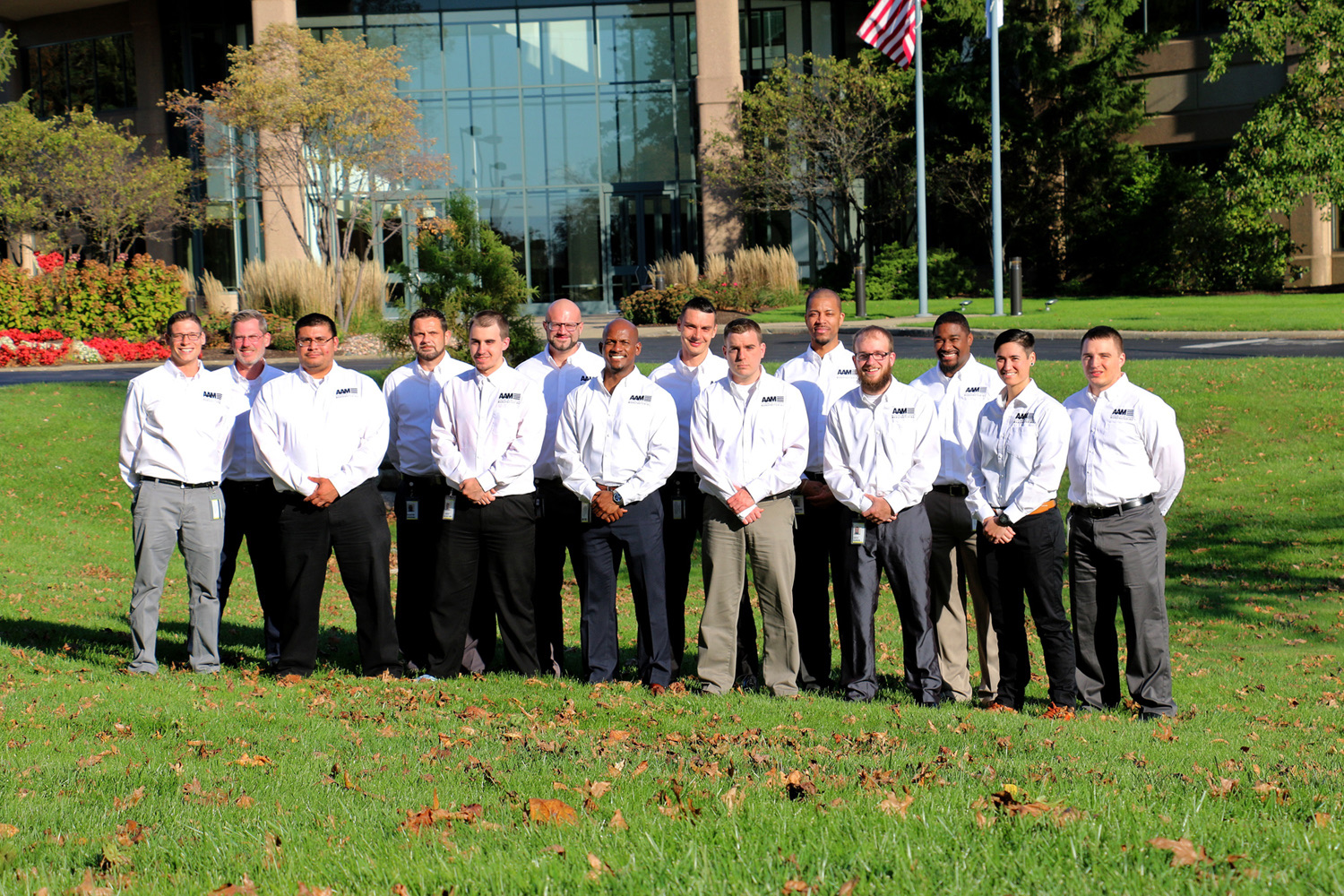
by Gary Mintchell | Nov 27, 2017 | Workforce
Rockwell has had a strong training program for many years. I took my first week-long class in 1991 or 1992. Altogether I have taken about six classes—controls, PLCs, drives, motor control centers, software. I know how intense the training can be.
Last week I posted a podcast of thoughts from Rockwell Automation’s annual series of events held the week prior to Thanksgiving. Now I’m in Spain at yet another conference and trying to get caught up on posts before I start a flurry of posts from here.
So first—training, diversity, and education.
When the company showed off some graduates of its new Academy of Advanced Manufacturing and they talked about the intensity of the three month program, memories came back.

Veterans
ManpowerGroup and Rockwell Automation celebrated the first military veterans to graduate from the Academy of Advanced Manufacturing and secure high-paying jobs in the rapidly-evolving manufacturing industry.
The 12-week program launched in August combines classroom learning with hands-on laboratory experience. Veterans are trained in Rockwell Automation’s state-of-the art facility in Mayfield Heights, Ohio for in-demand jobs in advanced manufacturing. All of the graduates have job offers and more than half have multiple job offers that significantly increase — some graduates even doubling — their previous salaries.
“This program felt like it was made just for me,” says Travis Tolbert, U.S. Navy veteran and academy graduate. “It focused on controls and automation, which is something I’ve always wanted to do, but was never able to do until now. The academy helped me take my military skills and understand how I could make them relevant for jobs outside of the Navy.”
“In recognition of Veterans Day, on behalf of Rockwell and ManpowerGroup, we thank all our veterans for their service,” said Blake Moret, CEO of Rockwell Automation. “We are honored to recognize our first military veterans to graduate the Academy of Advanced Manufacturing. We’ve seen their unique combination of core work and tech-savvy skills evolve to successfully position them for careers in the industry. We’re confident this program will help solve a challenge critical to the growth of advanced manufacturing.”
If the accomplishments and future prospects of these veterans didn’t bring a tear or two, you had to have no feelings.
Women
Rockwell Automation has been announced as a 2017 Catalyst Award winner. The Catalyst Award honors innovative organizational approaches that address the recruitment, development and advancement of women and have led to proven, measurable results.
“We are thrilled to receive this recognition from Catalyst for our Culture of Inclusion journey, demonstrating our commitment to our employees, customers and community,” said Moret. “Our people are the foundation of our company’s success, and so we must create an environment where employees can and want to do their best work every day.”
The Culture of Inclusion journey began in 2007 with senior leaders renewing their commitment to diversity, inclusion and engagement. This was in response to employee data showing that women and people of color at the company had lower retention rates than white men, and there were gaps in the levels of representation for key demographics. A driving force of this strategy is the knowledge that in order to effect sustainable change, the dominant group—in this case, white men—must be aware of the impact of their privilege, be engaged, and partner with women and underrepresented groups in a meaningful way.
Results: Between 2008 and 2016, women’s representation in the U.S. increased from 11.9% to 23.5% among vice presidents, from 14.7% to 23.2% among directors, and from 19.3% to 24.3% at the middle-manager level. At the most senior leadership levels, women’s representation doubled, increasing from 11.1% to 25.0% among the CEO’s direct reports and from 11.1% to 20.0% on the board of directors. In addition, the Rockwell Automation voluntary turnover is well below the benchmark average for women.
Youth
On the Automation Fair show floor, Jay Flores, Rockwell Automation global STEM ambassador, led me on a tour of the FIRST Robotics area and explained how Rockwell is continuing its commitment to the program.
It announced a $12M, four-year commitment to FIRST—For Inspiration and Recognition of Science and Technology—founded to inspire young people’s interest and participation in science and technology.
Over the past 10 years, Rockwell Automation has provided more than $15M of broad-based support to address the critical need to fill science, technology, engineering and math (STEM) jobs that drive innovation. Many of these jobs go unfilled because of both the lack of awareness of the kinds of high-tech jobs available and the lack of skills to qualify for today’s needs.
“Through our technology and people, we are helping to inspire the next generation of innovators to fill the talent pipeline for our customers and for our company,” said Moret. “Our strategic partnership with FIRST helps us increase our reach and visibility to STEM students around the world.”
In addition to being a global sponsor of the FIRST LEGO League program and sole sponsor of the FIRST Robotics Competition (FRC) Rockwell Automation Innovation in Control Award, nearly 200 Rockwell Automation employees around the world donate their time for the FIRST programs, and more than 300 employees volunteer for the organization in other capacities. The company also donates products integral to FIRST program games and scoring. These product donations are specifically used for the FIRST Robotics Competition playing fields and scoring systems, and they are included within the parts kits teams use to build their robots.
“This generous, multiyear commitment from Rockwell Automation will allow us to focus on the strategic aspects of our partnership while continuing to help scale our programs and expose students to a broader range of industry-leading products and applications,” said Donald E. Bossi, president, FIRST. “The company has a long, rich history of supporting FIRST.”


















